If you've ever pulled a muscle, you've probably wondered: “Should I ice this or turn up the heat?” We get it; it's a bit like being stuck between a hot rock and a cold, hard place. We’re here to unravel this age-old conundrum and help your sore muscles bounce back like never before.
Let's jump into the world of heat and cold therapy and discuss the benefits of each of these treatment methods. By the end, you’ll have a better understanding of when to use each.
What Is a Pulled Muscle?
A pulled muscle, or muscle strain, is what happens when your muscle fibers have stretched a bit too far or even torn. It can sneak up on any muscle in the body, but the lower back, neck, shoulders, and hamstrings are often the prime targets.
Usually, a pulled muscle occurs as a result of an abrupt movement or too much force exerted on the muscle, like during physical activity or heavy lifting.
Symptoms of a pulled muscle may include:
- Sudden onset of pain
- Soreness
- Limited range of motion
- Bruising or discoloration
- Swelling
- Weak or non-functioning muscle
The severity of these symptoms often depends on the extent of the injury. For instance, a minor strain might cause mild discomfort, while a severe strain can cause intense pain and limit your ability to move the affected muscle.
When Should I Use Ice for a Pulled Muscle?
Right after an injury, ice or a cold pack is typically recommended. This method, also known as cryotherapy, helps to soothe tension and numb the affected area, providing immediate relief from pain.
Ice performs its magic by causing the blood vessels to constrict, which reduces blood flow to the injured area. This response can minimize swelling and tension, and it can also lessen the amount of bruising.
For a fresh injury, consider applying an ice pack to the affected area for 15 to 20 minutes at a time, repeating every two to three hours for the first 24 to 72 hours. Remember to protect your skin by wrapping the ice pack in a thin towel before applying.
Ice, while a potent therapy, is not a cure-all — it should be used as part of a holistic treatment plan that may also include rest, compression, elevation, and possibly physical therapy.
Incorporating supplements such as iwi life's plant-based omega-3 can provide additional support to your muscles, maintaining your overall wellness during the healing process.
What Are the Benefits of Using Heat for Pulled Muscles?

Heat therapy is also beneficial when treating pulled muscles, particularly when dealing with injuries that are a few days old.
The cozy embrace of a heating pad or moist heat enhances blood flow to the affected region, delivering nutrient-rich oxygen to facilitate the healing process.
Heat can truly shine in the face of long-term discomfort or muscle spasms. It soothes and relaxes tissues, leading to a decrease in muscle spasms. Heat therapy could also be your ally in increasing the flexibility and range of motion of stiff joints or muscles.
When dealing with sore muscles, heat packs, hot water bottles, or even a hot bath can provide relief. The secret lies in applying heat for 15 to 20 minutes at a time, using a cloth barrier to prevent direct contact and safeguard your skin from burns. Keep in mind though, new injuries or swollen areas are often better off without heat, as it could potentially increase the swelling due to blood flow.
Are There Specific Considerations for Different Types of Discomfort?
Your choice of heat or ice can depend on the nature of your discomfort.
With muscle strains, you’ll usually want to follow the guidelines we've laid out above – ice for new injuries, and heat for older forms of discomfort. Ligament sprains, for example, typically need immediate icing to keep swelling and tension in check. Once the acute phase subsides, heat can enter the scene to help support proper blood flow and healing.
Remember, everyone's response to heat and cold therapy is somewhat unique. What works wonders for one may not hit the mark for another. When in doubt, don't hesitate to tap into the expertise of a healthcare professional or physical therapist. They can guide you on your unique path to wellness.
Adding nutritional supplements like iwi's plant-based omega-3 can further assist your journey towards health, offering much-needed support to your muscles during the healing process.
What Are the Rules of Thumb in Using Heat or Ice Therapy?
Navigating the world of heat or ice therapy can be a breeze when you stick to a few basic rules.
It's a no-go to let ice cubes or heat sources have direct contact with your skin, as this could lead to burns, frostbite, or other skin damage. Instead, it’s best to play it safe by using a barrier, such as a cloth or towel.
Choosing between a hot or cold method depends on your preferences, but some options include:
- A dip in a hot tub or steaming bath, or a hot water bottle can all provide soothing heat therapy.
- A cold compress, ice pack, or gel pack can be your ticket to effective cold therapy.
Regardless of your choice, ensure you apply the treatment for about 15 to 20 minutes at a time, with breaks as needed to protect your skin from potential damage.
When mixed into a physical therapy routine, heat or ice can assist in supporting your range of motion. While cold therapy can dial down tension and ease movement, heat therapy can lull muscles into relaxation, simplifying stretching exercises.
What Are Some Precautions To Keep in Mind When Using Heat or Ice Therapy?
While heat and ice therapy can be superheroes for relief, there are times when they might not be on your side. Overdoing it with ice, for example, could lead to nerve damage — this is rare, however.
People with certain conditions, such as Raynaud’s disease, generally need to tread cautiously. Being more susceptible to cold temperatures, they should approach cold therapy with care and under professional supervision — always consult your doctor for personalized advice and guidance.
The Bottom Line
As you can see, both heat and ice therapy strut their stuff in the healing process of a pulled muscle. Mastering the art of using each therapy can fast-track recovery, manage pain, and bring back functionality. Whether it's a new injury or a long-lasting muscle ache, the right application of heat or ice could be a game-changer on your wellness journey.
However, remember that these therapies are just part of the puzzle. Regular exercise, a balanced diet, ample rest, and optimal nutrition also hold keys to your wellness journey.
As part of your nutrition plan, don't overlook the potential of supplements that champion overall wellness. For instance, iwi life’s plant-based, sustainable omega-3 products can lend a helping hand to your body’s natural healing processes, support brain health, and maintain overall wellness.
Your healing journey is a journey of one. What works for you might not work for someone else. So, listen to your body, seek advice from healthcare professionals when needed, and discover the healing approach that hits the right note for you.
Sources:
Muscle Strain | Harvard Health
Muscle Strains: Causes, Symptoms, Treatment & FAQa | Cleveland Clinic
Cryotherapy Cold Therapy for Pain Management | Johns Hopkins Medicine
Using Ice and Cold Packs | My Health Alberta
Local Heat Therapy to Accelerate Recovery After Exercise-Induced Muscle Damage | PMC



















